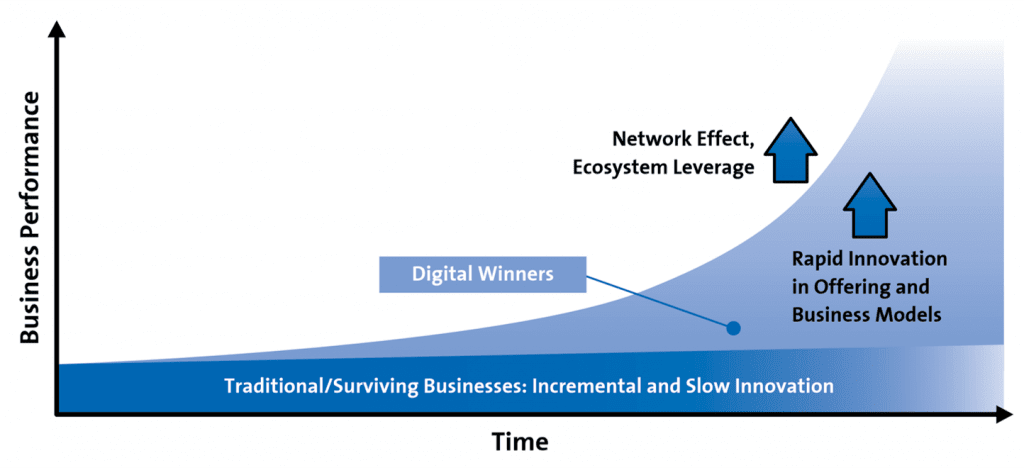Devastation caused by powerful earthquake shocks can often be drastic and far-reaching. The strongest earthquake in Valdivia, Chile (1960), had a magnitude of 9.5 and was felt in Hawaii, while the deadliest earthquake in Shaanxi, China, killed nearly a million people.[1] Shocks are typically unexpected and cause contrasting impacts due to differences in prevailing environments.
Many aspects of digital disruption are comparable to shocks from incidents such as earthquakes. Powered by the rapid emergence of a wide variety of affordable technologies and consequential changes in customer behaviour, major movements are taking place in the environments that businesses operate in – creating digital shocks. Businesses that are ‘born digital’ ride these shock waves well as they encounter them.
The situation is more acute for existing businesses – to survive and benefit from the shocks of digital disruption, they need to adapt quickly, in other words play by new rules that may differ significantly from the status quo.

The rules of business combine explicit and implicit strategies, tactics, norms and operating models. In the predigital era, business models and transactions were simpler and so were the rules governing them.
Business environments in this digital age, on the other hand, have many dimensions with rapidly evolving features that interact non-linearly, making the winning rules of business fundamentally complex.
As indicated in the figure above, the combination of (a) rapid innovation enabling the roll-out of new products and services at hyperspeed, (b) the network effect of customer adoption (i.e., adoption grows exponentially with the number of customers transforming the demand side), and (c) a newly dynamic partner/ supplier ecosystem (transforming the supply side) makes traditional incremental business evolution inadequate in the digital era.
The game of business competition has changed drastically, leading to a condition where often ‘the winner takes it all’ (think Google, Netflix, Uber, Airbnb, etc.) and therefore the urgent need to adopt new rules to play and lead.

Depending on what needs to change – either by the adoption of something new or by increasing the emphasis of something already prevailing – and where the change must occur, the following high-level categories of business rules are important for success in the digital age:
Business environment: This comprises external factors that drive the attitude and operation of the business. The key considerations are:
- The impact of the behaviour of the digital customer, who is typically quite knowledgeable about their needs, capable of carrying out competitive comparisons of what they need to purchase, rewards innovation, has low loyalty to brands, expects to be served and not just sold to, and thanks to social media is capable of greatly and rapidly pushing up or down a brand’s reputation.
- The need for businesses to operate in an ecosystem of partners and suppliers, and to leverage the ecosystem in order to create new offerings and to grow. These ecosystems need to be large and open with respect to the type, number and location of their members.
Business models: Business architecture, product/service delivery and monetisation strategies must adopt new rules to help the business lead in the digital environment where:
- Service often takes the form of a product to help the customer solve a problem and get a job done better (service as a product).
- Freemium and pay-as-you-use revenue models are commonly expected.
- Businesses must explore and leverage collaborative innovation and asset generation with customers and partners (e.g., TripAdvisor, LinkedIn).
- Enterprises unbundle their capabilities, allowing them to play at many levels in the ecosystem.
- Companies should seriously consider acquisition of (multiple) smaller (emerging) businesses to augment or expand their own capabilities and offerings.
Organisational structure and behaviour: These rules, mostly internal to the business, guide how a business organises itself and carries out its day-to-day operation to support the adoption of the rules in the previous two categories. Approaches compatible with success in the digital age include:
- Highly agile and adaptive organisational structures that are flatter and governed by commitment and collaboration as opposed to the command-and-control paradigm.
- An organisational culture promoting fast decision-making, rapid customer-centric innovation, risk-taking and continuous learning of advanced and emerging topics.
- Recasting of traditional information technology (IT) with ‘fast IT’ components (also known as two-speed or bimodal IT).[3]
- Establishing and rewarding tight and bidirectional business–IT collaboration.
In the digital era, ‘speed is of the essence’ – implicit in all of the above rules is that the business must execute its intentions and strategies much faster than in the predigital era.
In the move to digital leadership, however, the greatest challenge is to unlearn the rules of yesterday and embrace the new rules in an act of proactive disruption.
_____
[1] Fairclough, P.: ‘The 10 most powerful recorded earthquakes’, The Guardian Online, 2015.
[2] Christensen, C. M. et al.: ‘Competing against luck: The story of innovation and customer choice’, Harper Business, 2016.
[3] Bossert, O., Ip, C., Laartz, J.: ‘A two-speed IT architecture for the digital enterprise’, McKinsey, 2014.



